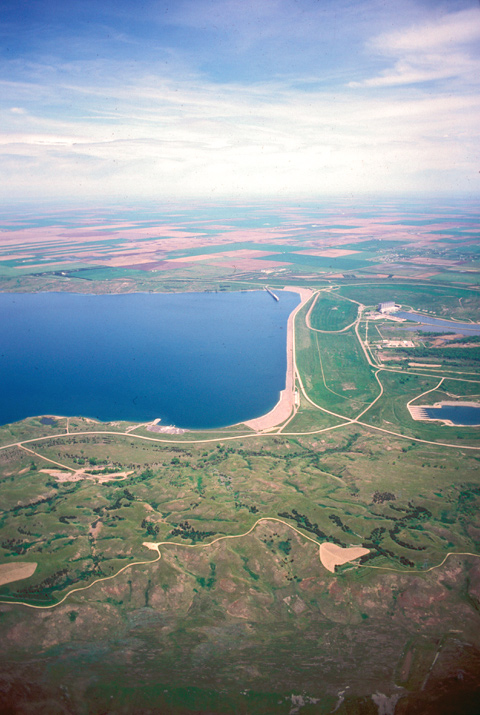Festivities
On the evening of 25 September 1804, after the determination of the Lakota Sioux to turn the expedition back had collided with the captains’ awkward diplomacy and firm resolve to move on, nearly igniting warfare, the Corps camped on a nearby island Clark called “bad humered Island as we were in a bad humer.” The next morning, the Indians had a change of heart, and the captains consented at “the particular request of the Chiefs to let their Womin & Boys See the Boat, and Suffer them to Show us some friendship.”
Nicholas Biddle condensed Clark’s extensive notes on the evening’s festivities: “Captains Lewis and Clark, who went on shore one after the other, were met on landing by ten well dressed young men, who took them up in a robe highly decorated and carried them to a large council house, where they were placed on a dressed buffalo skin by the side of the grand chief. . . . Under this shelter sat about seventy men, forming a circle round the chief, before whom were placed a Spanish flag and the one we had given them yesterday.”
It was indeed a festive scene. “6 feet Square was cleared,” Clark himself wrote,
. . . & the pipe of peace raised on forks & Sticks, under which was Swans down Scattered . . . a large fire was made on which a Dog was Cooked, & in the center about 400 wt of Buffalow meat which they gave us. . . . Soon after I took my Seat the young men went to the boat & brought Capt Lewis in the Same way [carried on a “neet Buffalow Roab”] & placed him by me. Soon after an old man rose & Spoke approving what we had done. requesting us to take pitty on them. . . .
The great Chief then rose in great State and Spoke to the Same purpos and with Solemnity took up the pipe of peace and pointed it to the heavens, the 4 quartrs and the earth, he made Some divistation [dissertation?], & presented the Sten [stem] to us to Smoke, after Smokeing & a Short Harang to his people we were requested to take the meat, and the Flesh of the Dog gavin us to eat. . . . We Smoked untill Dark, at which time all was cleared away & a large fire made in the Center, Several men with Tamborens highly Decorated with Der & Cabra [pronghorn] Hoofs to make them rattle, assembled and began to Sing & Beat. . . . the women Came forward highly decerated with the Scalps & Trofies of war of their fathes Husbands & relations, and Danced the war Dance, which they done with great chearfulness untill 12 oClock, when we informed the Chief we intended return on bord.
At dusk, dancing commenced and continued into the night. The Corps stayed at the Lakota Sioux village another day, then continued on their way on the twenty-eighth, satisfied that their firm diplomacy had diverted yesterday’s warlike mood into one of peace and friendship.
Oahe Dam
Oahe Dam, begun in 1948 and completed in 1963 for flood control, power generation, irrigation, and to control river flow for commercial navigation. Ironically, the word Oahe, once the name of a Christian mission, is a Siouan word meaning “a foundation,” or “a place to stand on.” But Lake Oahe has submerged more than 322 square miles of the Cheyenne River and Standing Rock Indian Reservations, including most of the tribes’ prime agricultural land. In fact, one-third of the Missouri River is now confined by dams and reservoirs. Here at the Oahe Dam, six miles north of Pierre, South Dakota, Lake Sharpe ends and Lake Oahe begins. Two hundred and thirty-one miles long, it is one of the largest man-made lakes in the United States. It is slowly filling up with silt.
From Discovering Lewis & Clark from the Air
Photography by Jim Wark
Text by Joseph Mussulman
Reproduced by permission of Mountain Press
Bad River Encounter Site is a High Potential Historic Site along the Lewis and Clark National Historic Trail managed by the U.S. National Park Service. The site is located in Fischers Lilly Park of the city of Fort Pierre.—ed.
Experience the Lewis and Clark Trail
The Lewis and Clark Trail Experience—our sister site at lewisandclark.travel—connects the world to people and places on the Lewis and Clark Trail.
Discover More
- The Lewis and Clark Expedition: Day by Day by Gary E. Moulton (University of Nebraska Press, 2018). The story in prose, 14 May 1804–23 September 1806.
- The Lewis and Clark Journals: An American Epic of Discovery (abridged) by Gary E. Moulton (University of Nebraska Press, 2003). Selected journal excerpts, 14 May 1804–23 September 1806.
- The Lewis and Clark Journals. by Gary E. Moulton (University of Nebraska Press, 1983–2001). The complete story in 13 volumes.





